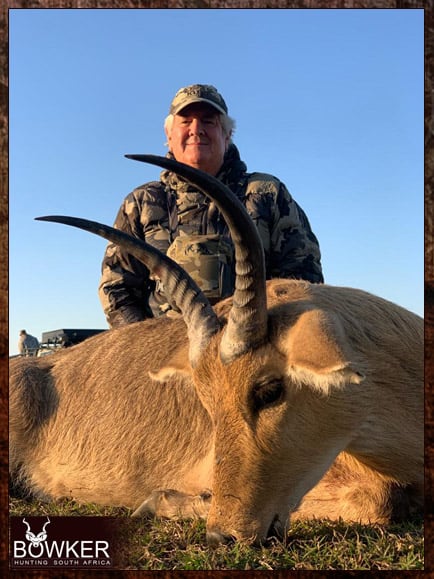
Summary
Common reedbuck hunting is often near the water as they are water-dependent, much like the waterbuck.
Reedbuck will often not run too far before stopping, giving the hunter an opportunity for a shot.
Common Reedbuck hunting has no seasonal restrictions in designated conservancies in the Eastern Cape of South Africa.
Nick Bowker Hunting offers Common Reedbuck game hunts in Africa year-round.
South Africa offers hunters the reedbuck slam.
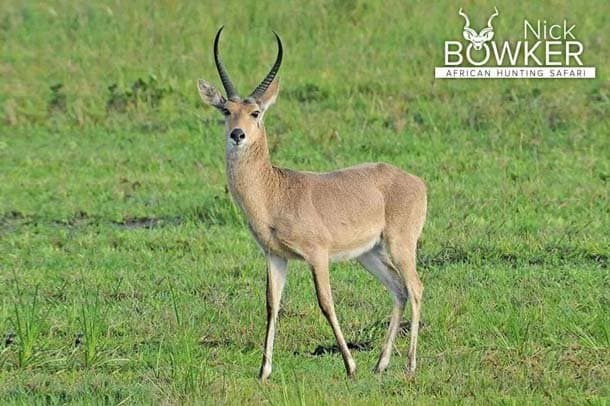
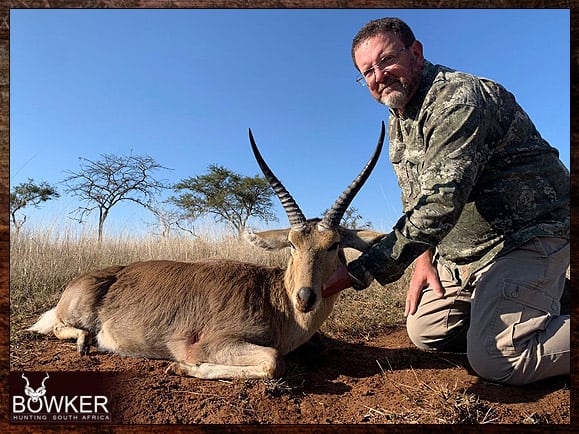
Table of Contents
Reedbuck Hunting Trophy Fees in South Africa -2025
The average price of Common Reedbuck is about $1600. Common Reedbuck hunting can be added to any package hunt.
Our Reedbuck price for 2025 is $1600.
The Common Reedbuck trophy hunting package includes a licensed hunting guide, a hunting license, and all South African permits.
Common Reedbuck Hunting in South Africa
Your Common Reedbuck trophy should have an average shoulder height of around 37 inches, weigh about 140 pounds, and have a horn length of approximately 12 inches.
The minimum Safari Club International score for a Common Reedbuck is 21. Add the length of each horn and the circumference of the bases to get your SCI score.
Common Reedbuck hunting and the mountain reedbuck and Vaal rhebok make up the reedbuck family shot in South Africa.
The reedbuck hunt slam involves shooting all three reedbuck species. All three reedbucks are available in the Eastern Cape, South Africa.
They have a distinctive “whistle” when alerted and use it significantly when indicating danger to others.
Common reedbuck are very alert and quick out of cover; reedbuck will never run too far before stopping, often giving the hunter an opportunity for a shot.
Like many African antelope, they lie up in the heat of the day and come out in the later afternoon to graze.
Sometimes confused with the impala or mountain reedbuck, the impala is much redder in color.
The mountain reedbuck is much smaller and a bit grayer in color.
Besides, the habitat is different, for as his name implies, he is predominantly on the mountainsides.
Common reedbuck hunting is conducted near water as they are water-dependent and found where water is abundant.
Common reedbuck will usually be found in pairs but can also be found in larger herds, particularly during the winter months.
Reedbuck is best hunted in the early morning or late afternoon and often in tall grass.
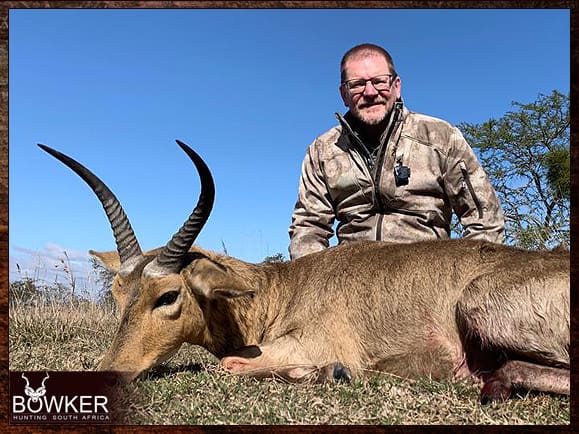

Shot placement must be in the bottom third of the animal directly above the front shoulder. This will ensure a heart or lung shot. Avoid head and neck shots, which are high-risk.
Trophy Judgement and Rifle Caliber for Hunting Common Reedbcuk
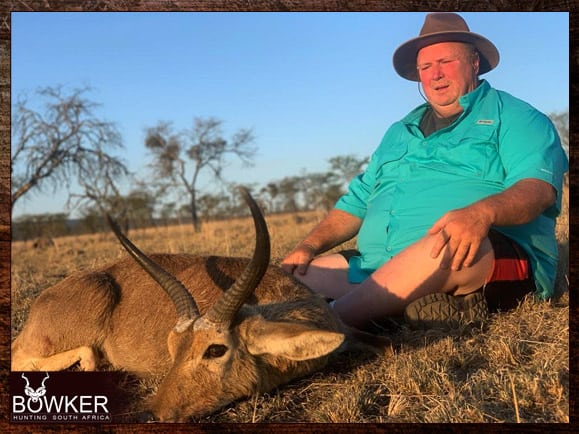
Your favorite deer rifle will be more than adequate to hunt common reedbuck.
For those hunters who wish to avoid going through the red tape of bringing a rifle into South Africa, Nick Bowker has 300 Winchester Magnums fitted with suppressors for your African hunt.
Mounted on the rifles are Swarovski Z8 tactical scopes. We have hand-loaded Hornady ELD-X ammunition for hunting reedbuck.
This setup, including ammunition, is free of charge for all hunting packages in South Africa.
The point of aim for hunters, along with all African animals, should be straight up the foreleg. This will result in a heart-lung shot, and you will have your trophy.
Always look for a dark black pulp on the base and horns with a good hook for overall length on your hunt.
The common reedbuck has a very well-set, thick neck and a fantastic hunt and mount, especially with the other reedbuck species. A reedbuck hunt is worthwhile on any hunting safari.
Africa reedbuck hunts are conducted in savanna areas or along river beds.
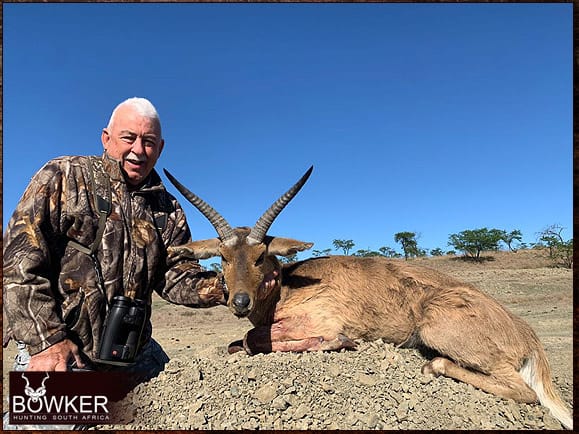
The Difference Between a Male and a Female for Reedbuck Hunts
Males have horns, while females do not.

Interesting facts for Your Common Reedbuck for Hunt
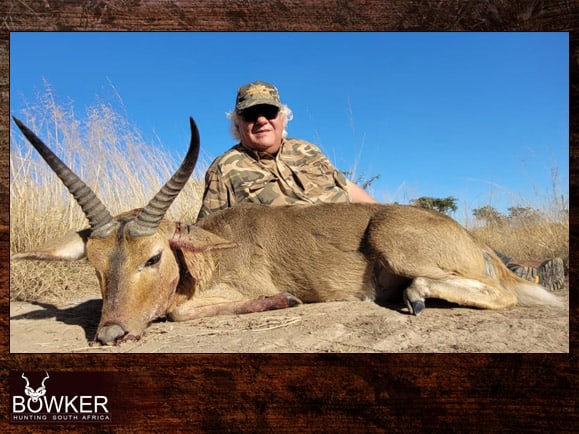
- There are three known types of reedbuck in Africa.
- Southern or common reedbuck
- Bohor reedbuck.
- The lifespan of the reedbuck is between 8 and 15 years.
- All three reedbuck game species have typical features; however, some distinct features separate each. In some places of the body, the reedbuck’s general color is a reddish-brown color.
- The coat color allows them to camouflage themselves in their habitat, which is almost the same color.
- The common reedbuck is the largest species of Africa reedbuck but is still a medium-sized antelope. The light-brown or greyish-brown animal has a silky coat and a lighter color on the neck and chest.
- Hunting common reedbuck can be added to our standard 7 animal packages, including trophies such as blesbok and springbok.
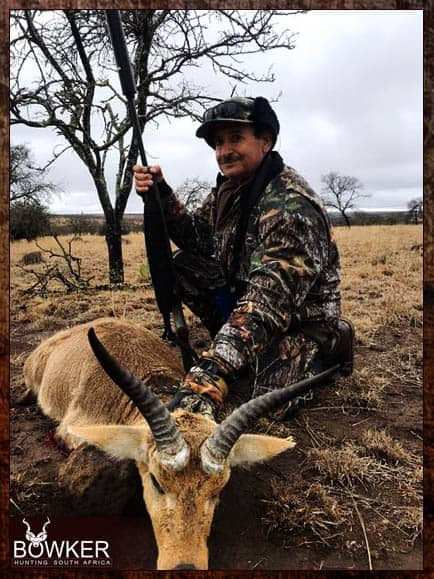
About the Common Reedbuck or Southern Reedbuck
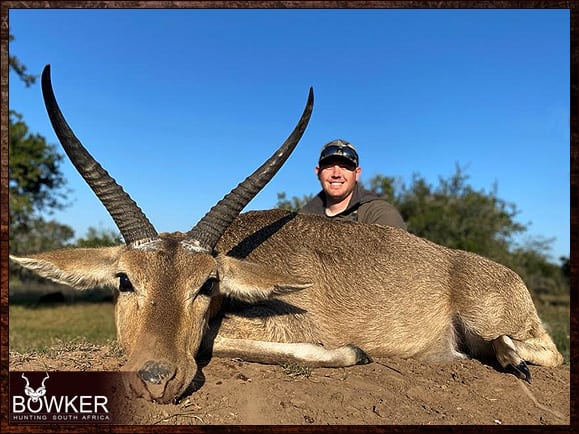
Description
Common reedbuck are larger than mountain reedbuck. It stands 31 – 35 inches at the shoulder. Females weigh 106 pounds, while males weigh 150 pounds.
It has a distinctive dark line running down the front of each of its forelegs and lowers hind legs, and whitish rings around the eyes. It has a lifespan of 10 years.
The coat is silky and almost woolly. Its coat ranges between light and grayish-brown and may be lighter on the neck and chest.
They have a glandular patch at the base of each ear, white fur covering the underparts, and the areas near the lips and chin.
The tail is the white underside and appears short and bushy. Common reedbucks measure an average of 33 inches at the shoulder.
Females lack horns. Males bear forward-curving horns, about 14–18 inches long, with the base having a distinct band of pale, rubbery tissue.
Common reedbuck live in pairs or alone. Sometimes, they form herds consisting of about 20 members.
They live in grass or reed beds in the day’s heat and come out and feed during sunrise and sunset or sometimes even at night.
Information for Common Reedbuck hunting
Old reedbuck are permanently territorial, with territories around 35-60 hectares, and generally live with a single female, preventing contact with rival males.
Females and young males perform an ‘appeasement dance’ for older males.
The dance involves the younger males running around speedily and taking long jumps, with the tail curled up and scented air released from a pocket in the groin at every bounce, making a popping sound.
Predators include big cats, spotted hyenas, Cape hunting dogs, pythons, and crocodiles.
They can camouflage themselves in the grass and reeds due to their coats, which are of a similar color.
If startled, they stand still, then either hide or flee and cautiously look back to ensure the danger is generally gone.
They use vocalizations like a shrill whistle through their nostrils and a clicking noise to alert others about the danger.
Common reedbuck hunting differs from hunting the mountain reedbuck due to the habitat difference—Hunt mountain reedbuck in rocky outcrops.
How much does it cost to hunt a Common Reddbuck?
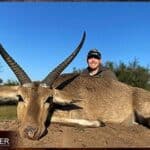
Trophy fees as a standalone Common Reedbuck hunt are around $ 1600. Daily rates vary between $250 and $500 per day for your hunt.
